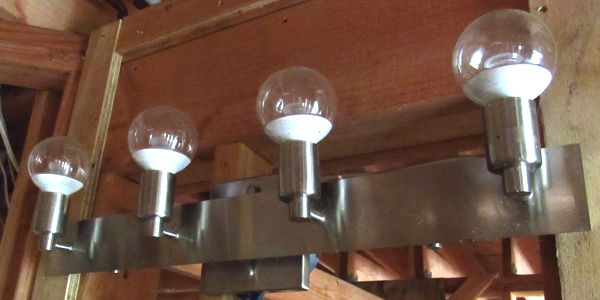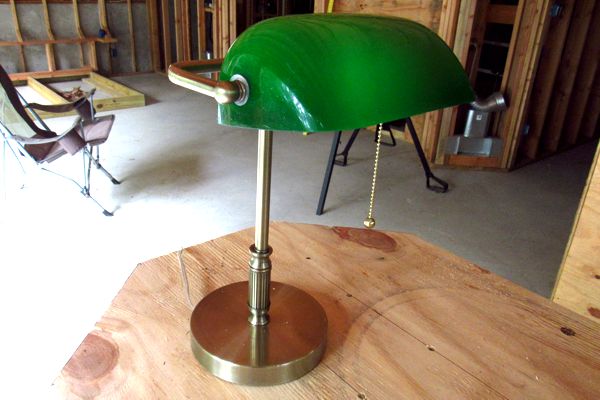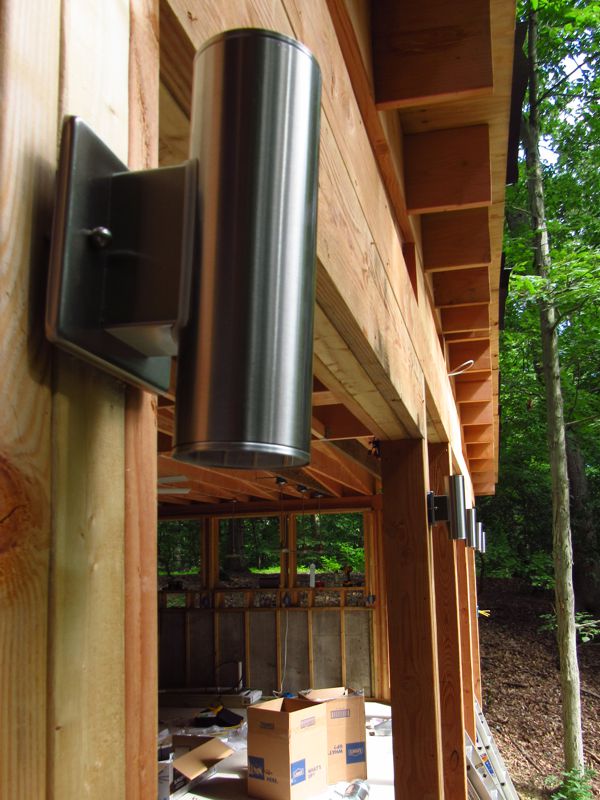Lighting
I'm extremely fussy about lighting. For starters, I don't like ceiling fixtures in living spaces (I'm fine with them in closets and such); I prefer most lighting near or below eye level. I insist on all lighting to be incandescent in color temperature. And I want total control over intensity: I like softer, dimmable general lighting, but intense task lighting for kitchen counters and other work spaces. Oh, and everything must be LED.
I'm equally fussy about lighting fixtures; I'm very picky about their appearance. I gravitate toward Euro, or what I think of as "conservative modern," as opposed to over-the-top "über modern" styling, which often comes off as garish or silly faux futuristic—stylish for the sake of being stylish. Simple and clean is my way of thinking; plus, I've long held a preference for brushed nickel as a fixture finish.
Practically from the time I closed on the property, I started looking at lighting fixtures. Over the course of more than three years of searching, I rarely found things that were close to what I sought, although the success rate has been improving (either because more appealing products are emerging, or I'm becoming less fussy—who knows). At one point, when I was deep in the throes of frustration, it occurred to me that I might be able to cobble together my own custom fixtures with parts from different products, which is what I sometimes wound up doing.
Pendant Lamps
The pendant lamps I found were pretty close to what I saw in my mind's eye, but unfortunately—and surprisingly—they had halogen bulbs, which are energy pigs, with most of the energy wasted as intense heat. I purchased one unit and tore it apart to see if I could convert it to LED. Turns out it was relatively easy. After removing all of the guts, I used the original metal internal reflector to hold a replacement candelabra lamp fixture, which threaded into it perfectly. Then I removed the metal mesh that prevented people from touching the hot halogen bulb to make room for a small LED globe bulb.

However, as noted in Chapter 9, I started having second thoughts about the "forest" of pendant lamps I'd planned for the kitchen. Consequently I tore them all out, and will install track lighting after the sheetrock is up.

However, after the ceilings were sheetrocked, it became evident that the tracks wouldn't work due to irregularities in the sheetrock (a consequence of some warped ceiling joists). What to do?

Wall Sconces
I'm not overly fond of sconces, but I much prefer them to ceiling fixtures for general lighting in living spaces (and table lamps are useless to me as there will only be one small coffee table in the middle of the living room). However, finding a sconce I liked turned out to be a really tall order. Ultimately I wound up making my own from two entirely different lighting products. I removed the lamp fitting from the inside of a so-so wall sconce I'd almost decided to use, and attached it to the base of a dismantled brushed nickel table lamp. Then I finished it off with a large LED globe bulb. The result is a fixture you'll never see anyplace other than my home.

Bathroom Lighting
The wall sconce solution also provided the answer to another vexing problem: the bathroom light over the sink. In this case, I started with a simple brushed nickel bar unit, and replaced the lamp fixtures with ones from the same wall sconces as before. The bonus is that the bathroom fixture perfectly matches my custom wall sconces, making it another item you'll never see anywhere else.

Headboard Lighting
I'd planned from the beginning to build lighting directly into the headboard: for those who read in bed, it's a much better lighting solution to table lamps. For a long time I'd considered deck step lights, since they're small and unobtrusive. But they're also low-voltage, requiring a special transformer to power them, which would likely preclude dimming. Then, as I was wandering around Lowe's dreaming of my someday home, I came across a new recessed ceiling fixture, and realized it was perfect for the headboard: it was small, it was dimmable, it was the same brushed nickel finish as everything else, and best of all, it was really cheap: less than $20. So, my headboard lighting problem was instantly solved, with nothing for me to do but install them in the finished headboard. Sometimes you just need to wait a while until a solution comes around.


Office Lighting
I won't need much light in my office—I prefer to keep the room relatively dark so that the computer monitor looks its best. For those occasions when I need to do mundane things like writing checks, I have a classic green glass banker's light. For reasons unknown, I've always liked them, and I got a cool faux-filament LED lamp for mine.

Utilitarian Lighting
In my book, utilitarian spaces don't require anything but utilitarian lighting. I'd wanted to use unobtrusive recessed lights in my closets, but most recessed lighting fixtures involve awkward wiring and mounting procedures. Eventually I came across an economical, compact semi-recessed LED fixture (it doesn't sit perfectly flush, which is fine) that's easily installed directly into standard ceiling boxes. Here are four of them temporarily mounted in the bedroom closet/laundry. They can be removed and installed in less than a minute. As a bonus, they're rated for wet environments, so I'm also using them in the shower.

Due to its size, the garage required a different approach to lighting, and for that I chose four-foot dual LED units. They resemble ubiquitous, old-fashioned fluorescent shop lights. It'll take ten units to provide sufficient illumination—six just for the workbench.
Outside Lighting
The fixtures I chose for the exterior doors were pretty much fine the way they came: they're just simple brushed nickel tubes with small floods inside facing up and down. I did have to convert them from halogen to LED, but that was a simple matter of replacing the lamps. As it happens, the manufacturer updated them to LED—after I'd bought all of the units I needed! But it turns out this was for the best, because the new units were more than double the price—it was cheaper to do what I'd done: get the old halogen units and convert them.


Five of these same units—one for each of the pillars holding up the roof—will illuminate the areas around the two sliding glass doors and the steps down to the main level of the deck.

Security Lighting
At one time there was a pair of security floodlights mounted at the peak of the roof over the deck (below left). However, the Township wanted me to revise the sheathing on the back of the house, which conflicted with these lights. So, I relocated them to the front of the house on 10 & 11 December 2018 to illuminate the parking area at the end of the driveway (below right).


